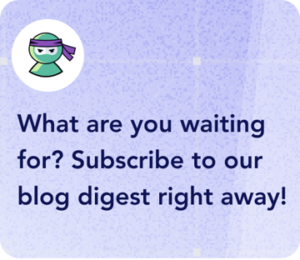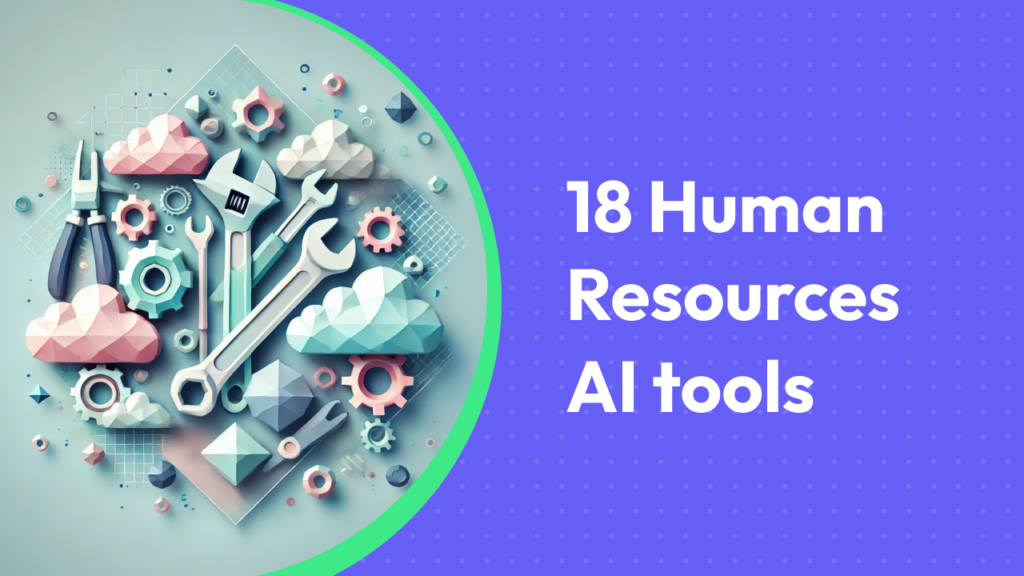- Benefits of AI in HR
- Key Areas for AI HR Transformation in 2025
- Transforming Recruitment and Hiring Processes
- Enhancing Onboarding and Offboarding
- Strategic Workforce Planning
- AI-Powered Chatbots and Virtual Assistants
- Omnimind’s step-by-step guide on how to create your own AI HR assistant (without a technical background)
- So, Will AI Replace HR Roles?
- How to Start Using AI in HR in 2025
- Challenges and Ethical Considerations of AI in HR
- Conclusion
Artificial Intelligence (AI) is revolutionizing industries worldwide, and Human Resources (HR) is at the forefront of this transformation. The global AI in HR market was worth $3.25 billion in 2023 and is expected to grow by 24.8% annually through 2030.

This rapid growth shows how quickly AI is becoming a core part of HR. Nearly 60% of companies already use AI for talent management. It plays a big role in hiring, employee engagement, and performance reviews.
However, adopting AI in HR comes with its own set of challenges. Issues like data privacy, cybersecurity, and ethics remain concerns for HR teams. As we approach 2025, solving these problems and staying ahead of HR tech trends is imperative for maintaining a competitive edge.
In this article, you’ll find key features, use cases, and actionable steps to start using AI tools. Whether you’re an HR leader or run a small business, this guide will help you unlock the full potential of using AI in HR!
Benefits of AI in HR
The integration of AI in HR is no longer a luxury—it’s a necessity for companies aiming to stay competitive. Let’s break down the key benefits that AI brings to the HR landscape:
- Time savings. Automating repetitive tasks frees up HR professionals for more strategic work, e.g. automated scheduling saves hours previously spent coordinating calendars.
- Improved hiring quality. AI’s data-driven insights lead to better hiring decisions, reducing turnover and enhancing team performance.
- Enhanced employee engagement. Personalized interactions foster a stronger connection between employees and HR, boosting morale and retention rates.
- Cost efficiency. Reduced recruitment and administrative costs make AI in HR a smart investment, with a proven ROI in many well-known organizations.
- Scalability. AI tools adapt as your organization grows, ensuring HR processes remain efficient and cost-effective.
As businesses grow more complex, the need for scalable, efficient solutions like AI becomes even more apparent. By using AI in HR, companies can create a culture of innovation, efficiency, and satisfaction that drives long-term success.
Key Areas for AI HR Transformation in 2025
Generative AI in HR could boost productivity by up to 30% in the near future, with the biggest impact on admin and shared services. Tasks like onboarding, payroll, and data management show the greatest automation potential.
However, strategic, relationship-driven aspects of HR will continue to rely heavily on human expertise, with AI serving as a supportive tool rather than a replacement. Employee engagement, relations, and DEI require more human involvement, limiting AI’s role.
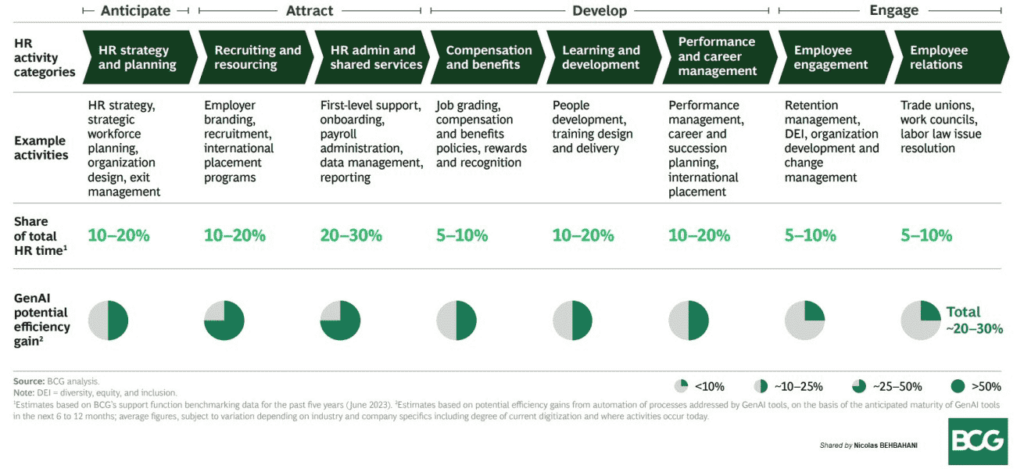
Transforming Recruitment and Hiring Processes
It has always been a time-intensive process, but now AI in HR recruitment can change this unfortunate fact dramatically. AI technologies are enabling companies to completely rethink how they approach hiring. By integrating AI, businesses can save time, reduce costs, and make the recruitment process even more inclusive.
- Automated resume screening. AI tools can quickly analyze thousands of CVs, shortlisting candidates who meet specific job requirements. This eliminates human bias and ensures fair consideration.
- For instance, Unilever, the global consumer goods company, implemented AI-driven recruitment tools to enhance its hiring process. By utilizing AI for CV screening and digital interviews, Unilever reduced its hiring time by 75% and increased the diversity of its hires.
- Another example is HiredScore—an AI platform that assists recruiters by analyzing resumes and identifying top candidates, streamlining the hiring process, and reducing time-to-fill positions.
- Interview insights. AI-powered platforms can summarize interview notes, highlight key competencies, and even predict a candidate’s cultural fit. For example, companies using HireVue’s AI-driven video assessments report up to a 90% increase in hiring efficiency.
- Tailored job postings. Generative AI in HR can craft job descriptions based on skill sets, company values, and market trends. It ensures job postings resonate with the right audience, as seen in the case of Textio—a tool that optimizes job descriptions to attract diverse talent pools.
- Another example: Amazon’s AI hiring tools initially faced challenges with bias but were redesigned to focus on neutral, data-driven decision-making. These improvements helped streamline their global recruitment efforts.
AI in HR recruitment creates opportunities to build workplaces that value diversity by removing unconscious bias and ensuring fairer hiring processes.
Enhancing Onboarding and Offboarding
An employee’s first and last experiences with a company are critical to their overall satisfaction and perception of your organization. AI tools can help HR teams make these transitions seamless and positive for employees. AI in HR simplifies onboarding and offboarding processes, ensuring they’re efficient and engaging:
- Seamless workflows. Tools like Omnimind guide new hires through personalized onboarding steps, reducing manual input and streamlining document submissions. For example, Siemens implemented an AI onboarding assistant that reduced the average onboarding time by 40%.
- Training personalization. AI in HR identifies knowledge gaps and recommends training tailored to individual roles and skill levels. PwC’s AI-driven learning platforms have helped employees upskill faster, boosting overall productivity.
- Exit interviews. AI-powered feedback systems identify actionable trends in employee departures, helping HR teams address retention challenges. Real-time analysis provides insights to improve organizational culture.
- Case in point: IBM uses AI to predict employee turnover, enabling preemptive action to retain key talent. The tech giant uses AI-driven sentiment analysis tools to monitor employee engagement and satisfaction, enabling proactive interventions to address concerns and improve workplace morale.
- JustEat: The online food delivery service leveraged AI-powered chatbots to engage candidates during the recruitment process, leading to a 50% reduction in recruitment time.
By automating repetitive tasks and offering tailored solutions, AI allows HR teams to focus on building meaningful connections with employees, both at the start and end of their journey with the company.
Strategic Workforce Planning
Workforce planning is essential for any organization looking to stay competitive in a rapidly changing market. AI provides HR teams with the tools to anticipate demands, address skill gaps, and align talent strategies with business goals. Simply put, using AI in HR just made planning your workforce’s future a lot easier:
- Predictive analytics. AI forecasts skill gaps and helps HR prepare for future needs. For instance, Shell uses AI to predict workforce demands, aligning hiring with upcoming projects and skill shortages.
- Data aggregation. Consolidating insights from employee performance, turnover, and industry trends allows for smarter decision-making. AI’s ability to process large datasets quickly gives HR teams a strategic edge.
For example:
- PepsiCo employed AI-driven workforce planning tools to optimize staffing levels during peak seasons, improving efficiency and reducing overtime costs by 25%.
- The healthcare company Johnson & Johnson introduced AI for “skills inference” to assess employee capabilities and guide training initiatives, promoting internal hiring and efficient talent utilization.
- The logistics firm DHL utilizes AI to evaluate worker skills and provide targeted training, enhancing workforce planning and productivity.
These tools enable HR leaders to move from reactive to proactive planning, ensuring their teams are ready for the challenges ahead.
AI-Powered Chatbots and Virtual Assistants
Today, your employees expect quick and personalized assistance. AI chatbots are the ultimate HR assistants, offering real-time support for:
- Answering employee questions about benefits, policies, and career opportunities. This improves accessibility to HR services.
- Recommending personalized training programs based on employee development goals and identified skill gaps.
- Providing performance feedback based on measurable data, making reviews more transparent and constructive.
Example: IBM’s Watson Assistant has revolutionized how HR departments handle employee queries, reducing response times and improving satisfaction rates. Similarly, Accenture’s chatbot, Amelia, now handles thousands of HR interactions daily, significantly cutting down response time.
Omnimind’s step-by-step guide on how to create your own AI HR assistant (without a technical background)
With the help of Omnimind.ai you can create your own support bot that helps employees to get fast access to company policies and instructions. No technical background is required!
Here’s how it can save the time of your HR managers on answering FAQ’s:
1. An employee asks a question either in a Slack bot, WhatsApp bot, or in a chat widget on a spare page.
2. The AI agent finds suitable information in the knowledge base and provides a detailed response.
This guide will walk you through setting up your HR assistant in Omnimind.ai to automate employee FAQs and streamline access to company policies.
Step 1. Create Your HR Assistant Project
- Sign up/Log in to Omnimind.ai and create a new project

- Add Knowledge to the Project—upload relevant HR documents or manually input company policies (e.g., salary details, payment policies, or procurement guidelines).

👉 At this stage, there are no tools, triggers, or workflows—it’s just a simple support chat powered by the knowledge you add.
Step 2. Integrate with Slack
- Navigate to the Install section in Omnimind
- Select Messenger or Slack Integration
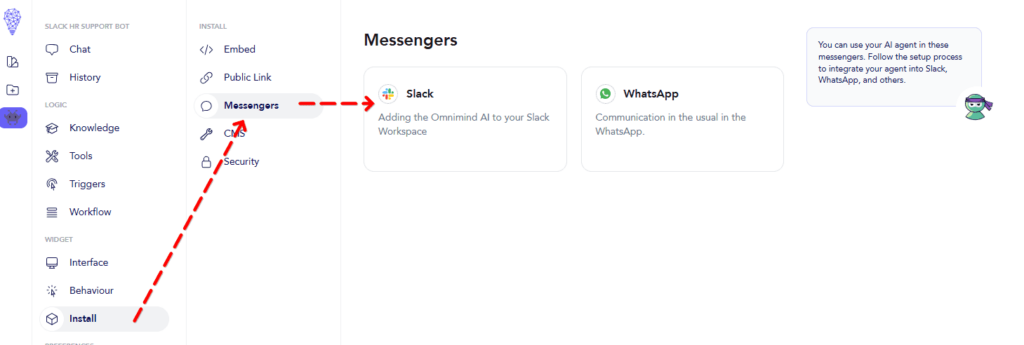
- Generate an API Key—this key connects your project to Slack
Note: API keys can expire, so periodically check to ensure it’s still valid
- Copy the API Key and Project ID (they should match the project where your knowledge base is stored).
Step 3. Add the Bot to Slack
- Open your Slack Workspace (ensure you have admin permissions)
- In Omnimind, click the Install button to begin integration
- Authorize the bot to access your Slack workspace

- Paste the API Key and Project ID into the Slack configuration window

- Submit—your HR assistant is now connected to Slack!

Step 4. Test the HR Assistant
- In Slack, ask a test question.
- If configured correctly, the bot will pull the answer directly from the knowledge base.
- Continue the conversation in the same thread or ask new questions as needed.
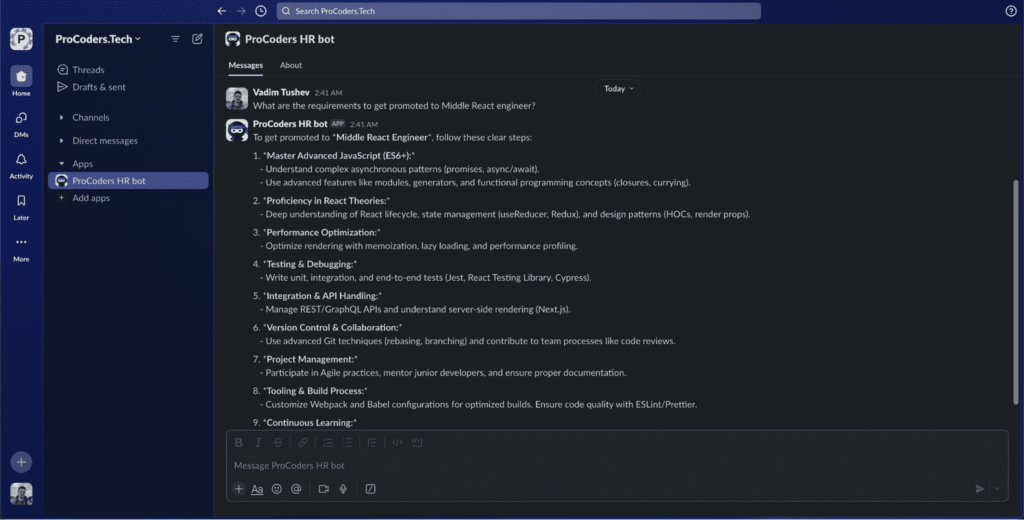
Step 5. Update the Knowledge Base
- To add new FAQs or policies, simply update the knowledge base in Omnimind.
- The bot will automatically access this updated information, ensuring employees receive the most current answers.
So, Will AI Replace HR Roles?
The short answer is no. ☺️Relax.
Many people fear that AI and automation in HR could replace human jobs, but this is far from the truth when it comes to HR. AI is here to enhance HR, not replace it.
Human resources is, at its core, a people-focused profession. AI in HR simply streamlines administrative tasks and enhances decision-making, freeing HR professionals to focus on what they do best: building relationships and fostering organizational culture.
What AI in HR Does Instead
- Content creation. From writing job descriptions to crafting employee communications, generative AI in HR is invaluable. Tools like ChatGPT save time and can help to ensure consistency in messaging.
- Data insights. AI analyzes performance reviews, salary benchmarks, and employee engagement data, providing actionable recommendations for HR strategies.
- Enhanced communication. AI tools personalize interactions, making HR feel more accessible and responsive. This fosters a culture of trust and transparency.
How to Start Using AI in HR in 2025
Starting with AI in HR doesn’t have to be overwhelming. Taking it step by step allows HR teams to integrate AI effectively and maximize its benefits. Here’s a short step-by-step guide.
Step 1: Identify Your HR Needs
Start by pinpointing the areas where your HR department faces challenges:
- Is onboarding taking too long?
- Are recruitment costs spiraling?
- Do employees feel disengaged?
List your pain points and prioritize them. Understanding where AI can provide the most value is crucial for successful implementation.
Step 2: Select the Right Tools
Not all AI tools can deliver the best results. Choose platforms designed for HR, such as:
- Omnimind: Ideal for onboarding and employee engagement.
- Workday: Comprehensive workforce management, including payroll and benefits administration.
- Eightfold.ai: Recruitment and talent planning with predictive analytics.
Evaluate these tools based on features, scalability, and cost to ensure they align with your organization’s goals.
Step 3: Train Your Team
Equip your HR staff with the skills to use AI effectively. Offer workshops on:
- AI ethics and data privacy to ensure compliance with regulations.
- Understanding AI-generated reports and insights for decision-making.
- Technical training on specific tools to maximize the potential of AI in HR.
Step 4: Pilot a Small Project
Start small to minimize risk. For example, use AI for onboarding workflows and measure the results—like time saved, error reduction, or employee satisfaction improvements. A successful pilot builds confidence in scaling AI applications.
Step 5: Monitor and Optimize
Regularly review the impact of AI in HR. Adjust the tools and processes based on feedback and performance data to ensure continuous improvement. For instance, if AI chatbots receive repeated queries on a specific topic, update training resources or policies to address the underlying issue.
Taking these 5 steps allows organizations to implement AI at their own pace to ensure a smoother transition and greater success in using AI in HR.
Challenges and Ethical Considerations of AI in HR
While AI offers numerous benefits, HR leaders have to navigate potential challenges:
- Bias in algorithms. AI systems can inadvertently perpetuate biases in hiring or performance evaluations. Regular audits and transparent algorithms are essential.
- Data privacy concerns. Handling sensitive employee data requires strict compliance with data protection laws and ethical guidelines.
- Resistance to change. Employees may resist AI adoption due to fear of job loss or unfamiliarity with technology. Clear communication and training can alleviate these concerns.
By addressing these challenges proactively, organizations can maximize the benefits of AI in HR while maintaining ethical standards.
Conclusion
AI and automation in HR are transforming it in ways we couldn’t have imagined a decade ago. By adopting AI tools, HR professionals can streamline processes, enhance employee experiences, and make more informed, data-driven decisions.
The key is to start small, focus on your department’s unique needs, and continuously optimize your approach.Are you ready to take your HR processes to the next level? Start exploring the power of AI in HR today with Omnimind and see the difference it can make in 2025 and beyond!

How useful was this post?
Click on a star to rate it!
Average rating 5 / 5. Vote count: 2
No votes so far! Be the first to rate this post.

